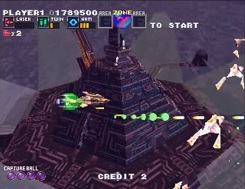
G-Darius
Darius is one of the series that helped to define Taito. From the time it first appeared, it turned heads in arcades. It would perform interesting technical feats like extending across multiple screens, making a very wide, ultra letter box-like presentation. Meanwhile, the series insisted on a rather unusual theme: fighting hordes of space faring mechanical fish. It may sound silly, but that’s what they did, and people accepted it without batting an eyelash. At the end of the day, these games were fun and offered a good challenge as shoot ‘em ups went. When G-Darius came along, it offered plenty more opportunities to shoot at fish without putting them in barrels, and also marked the series transition to polygons instead of sprites for its visuals. It looked and played great.At its core, the game stayed true to its predecessors, putting players in control of a Silver Hawk, the ship common throughout the series. Once more, humanity was threatened by alien invaders with an affinity for making their warships look like various see creatures. As usual, the game was a horizontal shoot ‘em up, and it continued the branching path approach that was present in previous games. This choice opened the door to an additional level of replayability as it created more variety in how players could traverse the game. With the case of G-Darius, players had even more places to go and baddies to fight.
For some, the transition to the polygonal aesthetic present in the game took a little bit of getting used to, but the game managed to stay true to the series. Environments were quite varied, giving a lot of different flavors to the game while players blasted up hordes of enemy ships coming at them. Of course, the bosses were the real stars of the game. G-Darius continued in the tradition of shoot ‘em up bosses prevalent throughout the 90s where bosses were massive, larger than life entities. Many would take up at least half of the screen, or players would only see the portion of the boss that inhabited that area while the game implied that what the player was fighting was in fact much larger than that. Boss fights very much took place on quite an epic scale, adding a lot of excitement to these encounters.
It’s not just the bosses that are fun to fight. The whole game offers a good challenge. Trying to 1cc the game would take a fair bit of practice. All the while, there are plenty of power-ups to help this along. Many of these help to enhance systems on the Silver Hawks like providing shields and missiles. However, the main piece of equipment players will make use of is the capture ball. This can be launched at enemies and does exactly what it says: it captures that ship, forces it alongside the player’s and is added to their arsenal. These ships have a variety of different weapon or defense systems. As such, they open the door to a lot of experimentation on the player’s part as they look for ones that work particularly well in specific areas or simply gel nicely with their play style.
One other thing that needs to be touched upon before closing up is the music, because what’s present in G-Darius is quite interesting. It’s a sort of synth-heavy electronic music but not in the traditional sense. There are some very unique choices of instrumentation and truly otherworldly melodies in this game that really set it apart from its contemporaries (or any shoot ‘em up to come along since then for that matter). If anything, the game’s music seems to have more in common with anime of that time than many of the videogames that were released during that era. It’s just a very unique, intriguing soundtrack.
In the end, G-Darius is certainly a classic in the shoot ‘em up genre. It took much of what made previous games in the series popular and modernized things with a new aesthetic. All the while, it provided a good challenge, a lot of branching paths to explore, and a truly unique soundtrack. Those who haven’t had the opportunity to try this game out would do well to track it down.
- IroIro
October 23, 2020
Other Shoot 'Em Ups We've Discussed:
- Arrow Flash Review (Mega Drive)- Philosoma Review (PlayStation)
- Super Aleste (SNES)
Genre: Shoot 'Em Up
Developer: Taito
Publisher: Taito
Released: 1997

PlayStation Box Art

Fighting outside an ocean base

Taking advantage of a large enemy with a capture ball

One of the game's gigantic bosses